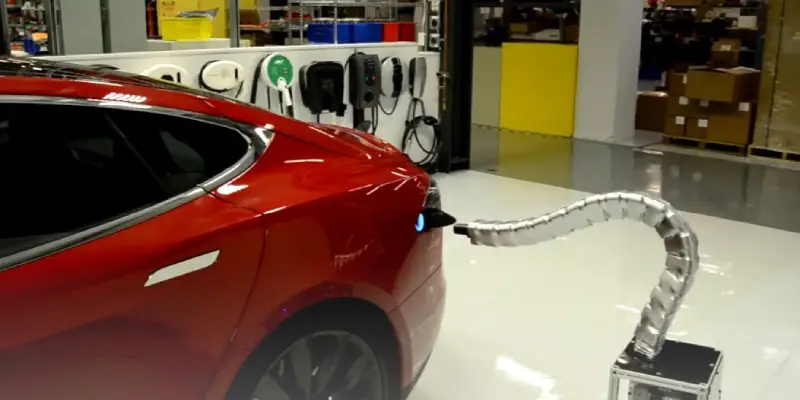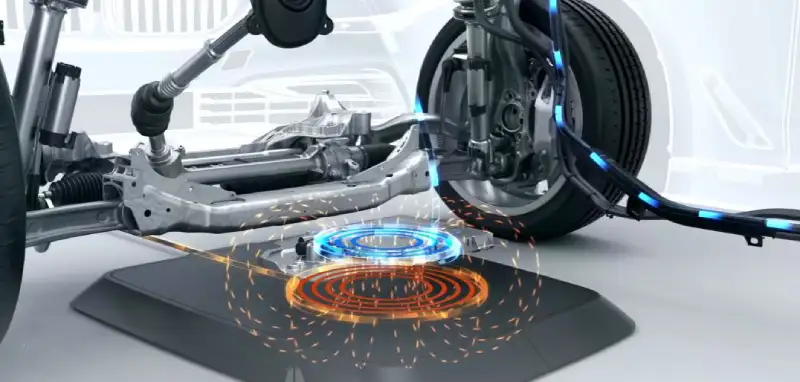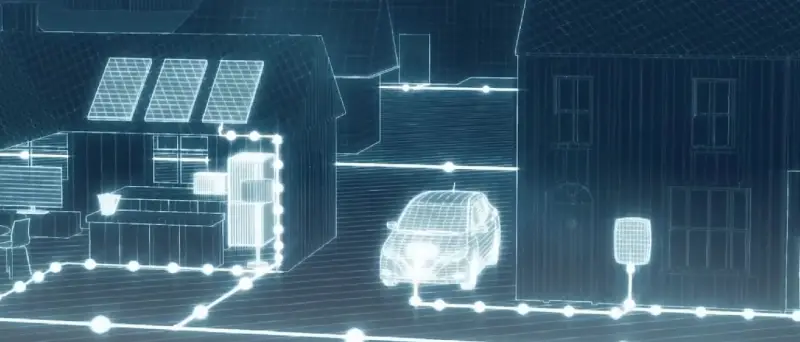Is Wireless EV charging a game-changer?
Like phone chargers, EV chargers share a common issue: not all plugs and charging stations are created equal. Some are slow, others fast; some fit, others don’t…
Though this might benefit certain manufacturers, it only compounds the difficulties for users, thus becoming a roadblock to EV adoption.
However, what if we told you that wireless EV charging could offer nearly identical efficiency and charging speeds, albeit at a minor premium?
Enter wireless EV charging.
Contents
- What’s wrong with tethered EV charging?
- The journey so far
- Turning the Dream into Reality
- WiTricity – US
- Other companies
- Are there any pitfalls?
- Conclusion
What’s wrong with tethered EV charging?

Historically, we’ve grown accustomed to ‘plugging in’ appliances and vehicles to recharge or refuel them. This physical connection between the electrical grid or fuel tanks and the appliances or vehicles is the most cost-effective and straightforward method to recharge or refuel.
However, we’re all aware of its inevitable drawbacks. Haven’t we all tripped over a laptop charger or watched videos of a fuel pump mishap where the nozzle gets accidentally disconnected from the car? Plugs, tethers, and nozzles inevitably degrade over time, and establishing a connection always requires at least a few seconds.
While there aren’t any estimates for the time spent “plugging” or the cost of mechanical wear and tear, it’s undoubtedly a significant amount of time and millions of dollars. And this doesn’t even take into account the costs of accidentally leaving something ‘unplugged’.
However, this doesn’t necessarily have to be the case. The renowned scientist Michael Faraday was transmitting energy wirelessly via magnetic and electric fields as early as the 1800s, circumventing the mechanical issues associated with physical connections.
The journey so far
The 1970s global energy crisis triggered a surge in interest in alternative energy technologies, including wireless energy transfer. Electric vehicles began to capture attention, and even wireless charging pilot tests were conducted in the US, France, and Germany.
However, this interest waned until the advent of mobile phones and smart devices reignited the desire to eliminate electrical tethers.
Qi wireless charging technology emerged as a pioneer, becoming the first mainstream, effective wireless charging method implemented globally. Although it’s ideal for mobile phones and electric toothbrushes, it falls short for EVs with sizeable Li-Ion batteries suspended off the ground.
Qi wireless charging is limited to short distances and can only achieve about 80% efficiency. Eighty percent efficiency may sound high, but the power required to charge an EV is significant, and business electricity prices are at record highs, making this loss unacceptable.
However, a significant breakthrough occurred in 2006 when resonant coupling technology was developed at MIT. This technology facilitates the safe transmission of significant power over longer distances, alignment offsets, and at very high efficiencies. It works similarly to induction cookers: the magnetic fields of two electrical coils ‘resonate’ with each other, transferring energy between them.
But the real game-changer was the announcement of the SAE J2954 global standard by the Society of Automotive Engineers (SAE) in October 2020. This standard provides guidance and recommendations for companies to start building their solutions, ensuring a commitment to global compatibility.
Turning the Dream into Reality

The dream of untethered charging is now sweeping the globe, with several companies finally pioneering their wireless charging technologies to consign tethered charging stations to history.
Imagine the convenience of never having to remember to plug in, never dealing with faulty connections, and the time saved by simply driving into a parking space knowing your EV is charging. This could soon be the reality with untethered wireless EV charging.
Let’s explore a few of these groundbreaking stationary wireless charging technologies:
WiTricity – US
Founded in 2007, WiTricity has been honing its magnetic resonance wireless technology for over a decade, positioning itself as a key player in the EV stationary wireless charging market. As a spin-off from MIT, they have licensed patented MIT intellectual property.
WiTricity’s solution can efficiently transfer power from a base plate buried a few centimetres underground to a receiver plate installed underneath an EV.
With a 90-93% power transfer efficiency between the induction plates, their product nearly matches the efficiency of a tethered connection, and only at a modest premium.
Their current prototype is an 11kW charger, comparable to the popular tethered Tesla Wall Connector charger, which delivers 35 miles of range per hour of charge. It’s fast enough for most commuters, but with the added benefit of not needing to plug in your vehicle every time you return home.
The beauty of magnetic resonance is that the alignment of the plates doesn’t have to be exact, allowing for some leeway when parking a vehicle within a wireless charging dock. This flexibility is due to magnetic resonance frequency: as long as the frequencies between the plates remain constant, it will charge effectively.
On the safety front, WiTricity strictly adheres to standards, addressing safety concerns of wireless charging like the safe implementation of Qi charging.
WiTricity chargers will be fitted with foreign object detection to avoid interaction with anything other than an EV and adhere closely to ground clearance standards to ensure metallic objects or the car structure do not come into contact with the induction plate.
They also utilise low frequencies of 85 kHz, confined to the area between the charging plates, minimising the likelihood of interaction with humans, animals, or essential medical devices like heart monitors and pacemakers.
The current cost for an automaker to install the wireless plate on their vehicle is around $700 US dollars, comparable to installing a new radio system or wheels. While the price for a home charging unit currently runs into the thousands of dollars, there’s a strong likelihood of significant price reductions due to economies of scale.
With the proliferation of smart gadgets and the potential implementation of electricity arbitrage strategies that allow you to profit from selling electricity back to your business energy supplier, these wireless chargers could quickly become part of distributed grids and emergency power supplies during blackouts.

With strong ties to manufacturers like General Motors, Nissan, and Toyota, and having acquired Qualcomm’s wireless electric vehicle charging technology, WiTricity is poised to be a significant part of the future of EV charging.
Other companies
Since the SAE J2954 standards release, there has been significant convergence among all the wireless EV charging startups.
Another early pioneer was Plugless Power (now known as Evatran), who have been instrumental in popularising the concept during the 2010s. Their product was already compatible with 80% of EVs in the US by 2017, and they have worked closely with companies such as Google and Tesla.
Another major company is Momentum Dynamics, hailing from Pennsylvania. Unlike WiTricity’s current solution, Momentum Dynamics specialises in higher-powered chargers of over 200kW, making them suitable for heavy-duty vehicles.
Are there any pitfalls?
As with any innovative technology, despite positive indicators, there are always risks of it not achieving widespread adoption.
Take Qi Wireless charging technology, for example. Despite its advantages over tethered connections, the market is still clearly in its growth stage, with most people still using tethered connections. Regulatory and technical hurdles have hampered its adoption, yet its market share is projected to quadruple by 2030.
It must be rigorously tested before EV wireless charging can claim its ultimate victory over tethered charging. This may take time, as the mass roll-out of tethered chargers began years ago. Unexpected security concerns or unreasonable social backlash—similar to the reactions experienced by 5G cellular networks—could also occur, among many other potential setbacks.
However, this is all speculative. The future for Wireless EV charging appears promising.
Conclusion
The EV market is experiencing rapid growth, and tethered charging has been the dominant technology.
However, we anticipate a significant shift in the near future, as wireless EV charging technology is poised to rival tethered charging, both technically and economically. Trailblazers like Witricity and others are gearing up to bring their innovative products to market.
However, as with all new technology, risks persist. Therefore, it would be prudent to allow this technology to prove its longevity before we bid farewell to the phrase “plugging in” once and for all.

